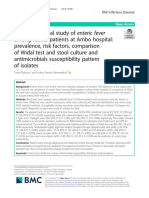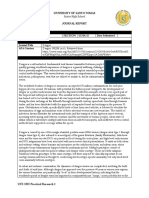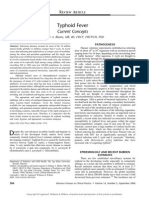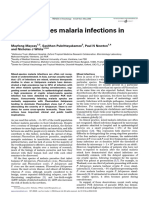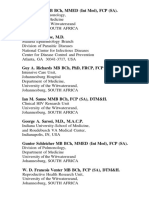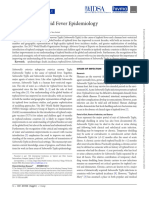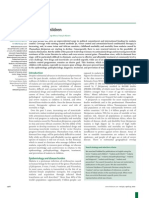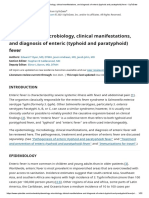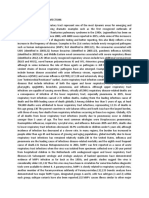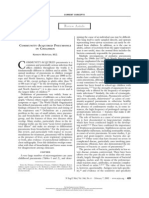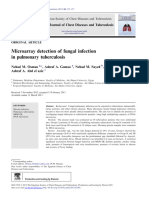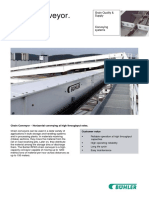Concurrent Malaria and Typhoid Fever in The Tropics: The Diagnostic Challenges and Public Health Implications
Concurrent Malaria and Typhoid Fever in The Tropics: The Diagnostic Challenges and Public Health Implications
Uploaded by
elsa_imamCopyright:
Available Formats
Concurrent Malaria and Typhoid Fever in The Tropics: The Diagnostic Challenges and Public Health Implications
Concurrent Malaria and Typhoid Fever in The Tropics: The Diagnostic Challenges and Public Health Implications
Uploaded by
elsa_imamOriginal Description:
Original Title
Copyright
Available Formats
Share this document
Did you find this document useful?
Is this content inappropriate?
Copyright:
Available Formats
Concurrent Malaria and Typhoid Fever in The Tropics: The Diagnostic Challenges and Public Health Implications
Concurrent Malaria and Typhoid Fever in The Tropics: The Diagnostic Challenges and Public Health Implications
Uploaded by
elsa_imamCopyright:
Available Formats
J Vector Borne Dis 45, June 2008, pp.
133142
Concurrent malaria and typhoid fever in the tropics: the diagnostic
challenges and public health implications
C.J. Uneke
Department of Medical Microbiology/Parasitology, Faculty of Clinical Medicine, Ebonyi State University, Abakaliki, Nigeria
Abstract
Background & objectives: Malaria and typhoid fever still remain diseases of major public health im-
portance in the tropics. Individuals in areas endemic for both the diseases are at substantial risk of con-
tracting both these diseases, either concurrently or an acute infection superimposed on a chronic one.
The objective of this report was to systematically review scientific data from studies conducted in the
tropics on concurrent malaria and typhoid fever within the last two decades (19872007), to highlight
the diagnostic challenges and the public health implications.
Methods: Using the MedLine Entrez-PubMed search, relevant publications were identified for the re-
view via the key words Malaria and Typhoid fever, which yielded 287 entries as of January 2008.
Results: Most of the studies reviewed expressed concern that poor diagnosis continues to hinder ef-
fective control of concurrent malaria and typhoid fever in the tropics due to: non-specific clinical pre-
sentation of the diseases; high prevalence of asymptomatic infections; lack of resources and insuffi-
cient access to trained health care providers and facilities; and widespread practice of self-treatment
for clinically suspected malaria or typhoid fever.
Interpretation & conclusion: There were considerably higher rates of concurrent malaria and typhoid
fever by Widal test compared to the bacteriological culture technique. Although culture technique
remains the gold standard in typhoid fever diagnosis, Widal test is still of significant diagnostic value
provided judicious interpretation of the test is made against a background of pertinent information.
Malaria could be controlled through interventions to minimize human-vector contact, while improved
personal hygiene, targeted vaccination campaigns and intensive community health education could
help to control typhoid fever in the tropics.
Key words Coinfection concurrent diagnosis malaria public health tropics typhoid fever
Introduction
Malaria and typhoid fever are among the most en-
demic diseases in the tropics. Both diseases have been
associated with poverty and underdevelopment with
significant morbidity and mortality. An association
between malaria and typhoid fever was first de-
scribed in the medical literature in the middle of the
19th century, and was named typhomalarial fever by
the United States Army
1
. However, by the end of 19th
century, laboratory tests had eliminated this theory as
they found that it was either one thing or the other, or in
rare instances, co-infection with both Salmonella typhi
and the Plasmodium species
1
. In the last two decades,
this relationship between the two diseases has been
substantiated by studies from Africa and India
26
.
J VECTOR BORNE DIS 45, JUNE 2008
134
Malaria remains the most complex and overwhelm-
ing health problem, facing humanity in vast majority
of tropical and sub-tropical regions of the world, with
300 to 500 million cases and 2 to 3 million deaths per
year
7
. About 90% of all malaria deaths in the world
today occur in the sub-Saharan Africa and this is
because majority of infections are caused by Plasmo-
dium falciparum, the most dangerous of the four
human malaria parasites (P. falciparum, P. ovale, P.
vivax, P. malariae), accounting for an estimated 1.4
to 2.6 million deaths per year in this region
8,9
. In
addition, the most effective malaria vector, Anoph-
eles gambiae is the most wide spread in the region
and the most difficult to control
9
. In areas where
malaria is highly endemic, a protective semi-immu-
nity against P. falciparum is acquired during the first
1015 years of life, and the majority of malaria-
related morbidity and mortality happen in young
children
10
.
On the other hand, typhoid fever is widely recognized
as a major public health problem in most developing
tropical countries. It is a systemic infectious disease
characterized by an acute illness, the first typical
manifestations of which are fever, headache, abdomi-
nal pain, relative bradycardia, splenomegaly, and
leukopenia
11,12
. The etiological agent of typhoid fe-
ver is Salmonella enterica sub-sp enterica serotype
Typhi. Typhoid fever is an important cause of mor-
bidity in many regions of the world, with an estimated
12 to 33 million cases occurring annually
13
. Cases are
more likely to be seen in areas like India, South and
Central America, and Africa with rapid population
growth, increased urbanization, and limited safe
water, infrastructure, and health systems. It is esti-
mated that there are more than 13 million cases
occurring annually in Asia alone of which a large pro-
portion occur during childhood
14
, and in the wake of
emerging multidrug-resistant strains of bacteria caus-
ing typhoid fever, the disorder is known to be asso-
ciated with significant morbidity and mortality
15,16
.
Human beings are the only reservoir and host for
typhoid fever and is transmitted by faecally contami-
nated water and food in endemic areas especially by
carriers handling food
11
. The disease has important
socioeconomic impact because, most of the time,
several months are necessary for a patient to recover
and be able to work again.
Although typhoid and malaria are caused by very dif-
ferent organismsone a gram negative bacilli, the
other a protozoan, and transmitted via different
mechanisms, both diseases share rather similar symp-
tomatology. However, the precise incidence of the
concurrent malaria and typhoid fever in most geo-
graphical areas is largely uncertain. Because both
typhoid and malaria share social circumstances which
are imperative to their transmission, individuals in
areas endemic for both diseases are at substantial risk
of contracting both these diseases, either concurrently
or an acute infection superimposed on a chronic
one
17
. While high prevalence of malaria is an estab-
lished fact, it is only within the last decade that an un-
usually high number of illnesses have been diagnosed
as malaria co-existing with typhoid fever
26
. Malaria
and typhoid fever often present with mimicking
symptoms especially in the early stages of typhoid fe-
ver
2,3
. The situation often presents a diagnostic prob-
lem and in some cases could lead to diagnostic con-
fusion. As a result of this, the importance of defini-
tive laboratory-based diagnosis cannot be overstated.
Before an individual is said to have concurrent ma-
laria and typhoid fever, the presence of Plasmodium
species and Salmonella enterica sub-sp enterica se-
rotype Typhi must be demonstrated in the patients
laboratory specimens.
Conventional light microscopy is the established
method for the laboratory confirmation of malaria
and is the most commonly used method for malaria
diagnosis in the tropics. The careful examination by
an expert microscopist of a well-prepared and well
stained blood film remains currently the gold stan-
dard for detecting and identifying malaria para-
sites
18
. In most settings, the procedure consists of:
collecting a finger-prick blood sample; preparing a
UNEKE: MALARIA AND TYPHOID FEVER CO-INFECTION 135
thick blood smear (in some settings a thin smear is
also prepared); staining the smear (most frequently
with Giemsa); and examining the smear through a
microscope (preferably with a 100x oil immersion
objective) for the presence of malaria parasites
19
.
Microscopy offers many advantages. It is sensitive,
informative, relatively inexpensive, is a general diag-
nostic technique that can be shared with other disease
control programmes, and can provide a permanent
record (the smears) of the diagnostic findings and be
subject to quality control
18
.
The definitive diagnosis of typhoid fever requires the
isolation of Salmonella enterica serotype Typhi from
the patient. Cultures of blood, stool, urine, rose spots,
blood mononuclear cell-platelet fraction, bone mar-
row, and gastric and intestinal secretions can all be
useful for diagnosis
11
. However, this requires labora-
tory equipment and technical training that are beyond
the means of most primary health care facilities in the
developing world. Consequently, Widal test is the
only specific diagnostic investigation available in
most tropical regions. The Widal test which is readily
available and inexpensive was introduced as a sero-
logic technique to aid in diagnosis of typhoid fever
and has been used for more than a century. The test
was based on demonstrating the presence of aggluti-
nin (antibody) in the serum of an infected patient,
against the H (flagellar) and O (somatic) antigens of
Salmonella typhi. The role of the Widal test had been
to increase the index of suspicion for the presence of
typhoid fever by demonstrating a positive agglutina-
tion during the acute and convalescent period of in-
fection with evidence of a four-fold rise of antibody
titre
20
. The Widal test reaction involves the use of
bacterial suspensions of S. typhi and S. paratyphi A
and B, treated to retain only the O and H anti-
gens. These antigens are employed to detect corre-
sponding antibodies in the serum of a patient sus-
pected of having typhoid fever. The IgM somatic O
antibody appears first and represents the initial sero-
logic response in acute typhoid fever, while the IgG
flagella H antibody usually develops more slowly but
persists for longer
11,20
. Two types of agglutination
techniques are available: the slide test and the tube
test.
In most parts of the tropics, the specific diagnosis of
concurrent malaria and typhoid fever is based on
blood smear microscopy and Widal test and in rare
cases with the inclusion of bacterial culture. How-
ever, it is of concern that poor diagnosis continues to
hinder effective malaria and typhoid control in the
tropics. This is due to a combination of factors, in-
cluding non-specific clinical presentation of the dis-
eases, high prevalence of asymptomatic infections in
many areas, lack of resources and insufficient access
to trained health care providers and health facilities,
and widespread practice of self-treatment for clini-
cally suspected malaria or typhoid fever.
Despite the importance of concurrent malaria and
typhoid fever in the tropics, the challenges associated
with the diagnosis and the public health implications
have not been comprehensively reviewed. The ob-
jective of this report was to systematically review
scientific data from studies conducted in the tropics
that provided information on malaria and typhoid
fever coinfection. The implications of findings from
these studies and their association with the risk, man-
agement, and treatment of the concurrent infection,
public health policy, and operational research needs
in the endemic areas of the tropics are discussed.
Material & Methods
This systematic review was designed to address the
following key questions: (a) What are the challenges
associated with the diagnosis of concurrent malaria
and typhoid fever in the tropics?; (b) What are the
limitations of the present conventional diagnostic
techniques and tools employed in the diagnosis of
malaria and typhoid fever in the tropics?; (c) What are
the public health implications of misdiagnosis (un-
der-diagnosis or over-diagnosis) of concurrent ma-
laria and typhoid fever in the tropics?; and (d) What
J VECTOR BORNE DIS 45, JUNE 2008
136
are the appropriate public health measures required
to address concurrent malaria and typhoid fever in the
tropics? A Medline Entrez-PubMed search was per-
formed and studies conducted in the tropics on con-
current malaria and typhoid in the last two decades
(19872007) and reported in English were identified.
Combinations of key words such as Malaria and Ty-
phoid fever were used for the search which yielded
287 entries as of January 2008. Selected publications
obtained from Google search using the key words
Malaria, Typhoid fever, Coinfection and Tropics rel-
evant to the topic were also identified and used as
additional literature for the review. Bibliographies of
all publications obtained were checked for additional
relevant references and were obtained and included
in the review. Particular attention was paid to articles
providing information on the diagnosis of concurrent
malaria and typhoid fever. The various reports were
systematically reviewed with respect to the method
of sample collection/analysis, location, population,
the period, setting, and the type of study to enhance
comparison between studies.
Results
In all thirteen studies, which provided sufficient in-
formation on concurrent malaria and typhoid fever to
enable meaningful and reasonable comparisons, were
identified and reviewed. These 13 studies fulfilled the
following inclusion criteria: (i) Study conducted be-
tween 1987 and 2007; (ii) Study conducted in tropi-
cal countries endemic for malaria and typhoid fever;
(iii) Study design is case-control investigation; (iv)
Both malaria and typhoid fever screening conducted
on the study population; and (v) Laboratory diagno-
sis of malaria using blood smear microscopy and ty-
phoid fever using either Widal test or bacterial cul-
ture or both. The summary of findings is presented in
Table 1. All the 13 studies reviewed were case-con-
trol investigations and made use of thick and thin
blood smear microscopy for laboratory diagnosis of
malaria. Two studies used both Widal and bacterio-
logical culture techniques
2,21
, five studies used only
T
a
b
l
e
1
.
S
u
m
m
a
r
y
o
f
s
t
u
d
i
e
s
r
e
p
o
r
t
i
n
g
c
o
n
c
u
r
r
e
n
t
m
a
l
a
r
i
a
a
n
d
t
y
p
h
o
i
d
f
e
v
e
r
i
n
t
h
e
t
r
o
p
i
c
s
A
u
t
h
o
r
s
(
R
e
f
)
Y
e
a
r
o
f
T
y
p
e
o
f
S
t
u
d
y
N
u
m
b
e
r
/
P
a
t
i
e
n
t
P
r
e
v
a
l
e
n
c
e
o
f
c
o
i
n
f
e
c
t
i
o
n
/
p
u
b
l
i
c
a
t
i
o
n
s
t
u
d
y
l
o
c
a
t
i
o
n
c
a
t
e
g
o
r
y
T
y
p
h
o
i
d
f
e
v
e
r
l
a
b
o
r
a
t
o
r
y
t
e
s
t
M
a
b
e
y
e
t
a
l
(
3
0
)
1
9
8
7
C
a
s
e
c
o
n
t
r
o
l
G
a
m
b
i
a
N
A
1
1
%
;
B
a
c
t
e
r
i
a
l
c
u
l
t
u
r
e
O
n
u
i
g
b
o
(
2
7
)
1
9
9
0
C
a
s
e
s
t
u
d
y
E
n
u
g
u
N
i
g
e
r
i
a
1
5
w
i
t
h
f
e
v
e
r
7
0
%
;
W
i
d
a
l
t
e
s
t
(
>
1
:
8
0
f
o
r
O
a
n
t
i
g
e
n
s
)
S
a
m
a
l
&
S
a
h
u
(
2
4
)
1
9
9
1
C
a
s
e
s
t
u
d
y
B
u
r
l
a
I
n
d
i
a
5
2
w
i
t
h
m
a
l
a
r
i
a
1
5
.
4
%
;
W
i
d
a
l
t
e
s
t
(
>
1
:
8
0
f
o
r
O
a
n
t
i
g
e
n
s
)
J
h
a
v
e
r
i
e
t
a
l
(
2
2
)
1
9
9
5
C
a
s
e
c
o
n
t
r
o
l
S
u
r
a
t
I
n
d
i
a
9
0
w
i
t
h
m
a
l
a
r
i
a
1
4
.
5
8
%
;
W
i
d
a
l
t
e
s
t
(
>
1
:
8
0
f
o
r
O
a
n
t
i
g
e
n
s
)
O
l
o
p
o
e
n
i
a
e
t
a
l
(
2
3
)
1
9
9
6
C
a
s
e
c
o
n
t
r
o
l
L
a
g
o
s
N
i
g
e
r
i
a
4
5
w
i
t
h
m
a
l
a
r
i
a
1
2
%
;
W
i
d
a
l
t
e
s
t
(
>
1
:
8
0
f
o
r
O
a
n
t
i
g
e
n
s
)
A
m
m
a
h
e
t
a
l
(
2
)
1
9
9
9
C
a
s
e
c
o
n
t
r
o
l
B
e
a
u
C
a
m
e
r
o
o
n
2
0
0
w
i
t
h
f
e
v
e
r
1
7
%
;
B
a
c
t
e
r
i
a
l
c
u
l
t
u
r
e
4
7
.
9
%
;
W
i
d
a
l
t
e
s
t
(
>
1
:
8
0
f
o
r
O
a
n
t
i
g
e
n
s
)
T
a
n
y
i
g
n
a
e
t
a
l
(
2
6
)
2
0
0
1
C
a
s
e
c
o
n
t
r
o
l
J
o
s
N
i
g
e
r
i
a
2
3
w
i
t
h
m
a
l
a
r
i
a
4
.
4
%
;
W
i
d
a
l
t
e
s
t
(
>
1
:
8
0
f
o
r
O
a
n
t
i
g
e
n
s
)
O
h
a
n
u
e
t
a
l
(
3
)
2
0
0
3
C
a
s
e
c
o
n
t
r
o
l
E
n
u
g
u
N
i
g
e
r
i
a
2
7
0
w
i
t
h
f
e
v
e
r
2
6
.
6
%
;
B
a
c
t
e
r
i
a
l
c
u
l
t
u
r
e
M
b
u
h
e
t
a
l
(
2
1
)
2
0
0
3
C
a
s
e
c
o
n
t
r
o
l
Z
a
r
i
a
N
i
g
e
r
i
a
2
1
8
w
i
t
h
m
a
l
a
r
i
a
0
.
5
%
;
B
a
c
t
e
r
i
a
l
c
u
l
t
u
r
e
1
0
.
1
%
;
W
i
d
a
l
t
e
s
t
(
>
1
:
1
6
0
f
o
r
O
a
n
t
i
g
e
n
s
)
S
m
i
t
h
e
t
a
l
(
3
1
)
2
0
0
4
C
a
s
e
c
o
n
t
r
o
l
L
a
g
o
s
N
i
g
e
r
i
a
5
0
w
i
t
h
f
e
v
e
r
1
8
%
;
B
a
c
t
e
r
i
a
l
c
u
l
t
u
r
e
I
b
a
d
i
n
&
O
g
b
i
m
i
(
2
5
)
2
0
0
4
C
a
s
e
c
o
n
t
r
o
l
B
e
n
i
n
C
i
t
y
N
i
g
e
r
i
a
1
8
9
w
i
t
h
m
a
l
a
r
i
a
2
7
.
5
%
;
W
i
d
a
l
t
e
s
t
(
>
1
:
8
0
f
o
r
O
a
n
t
i
g
e
n
s
)
K
h
a
n
e
t
a
l
(
2
9
)
2
0
0
5
C
a
s
e
c
o
n
t
r
o
l
K
a
r
a
c
h
i
P
a
k
i
s
t
a
n
1
8
9
1
w
i
t
h
m
a
l
a
r
i
a
1
.
1
1
%
;
B
a
c
t
e
r
i
a
l
c
u
l
t
u
r
e
A
k
i
n
y
e
m
i
e
t
a
l
(
2
8
)
2
0
0
7
C
a
s
e
c
o
n
t
r
o
l
L
a
g
o
s
N
i
g
e
r
i
a
1
0
7
w
i
t
h
m
a
l
a
r
i
a
1
4
.
9
5
%
;
B
a
c
t
e
r
i
a
l
c
u
l
t
u
r
e
N
A
:
I
n
f
o
r
m
a
t
i
o
n
n
o
t
a
c
c
e
s
s
i
b
l
e
.
UNEKE: MALARIA AND TYPHOID FEVER CO-INFECTION 137
the bacteriological culture techniques, while the re-
maining six studies used only the Widal technique
(Table 1). Eight of the studies were conducted in
Nigeria, two from India, one each from Cameroon,
Gambia and Pakistan.
The prevalence of malaria and typhoid coinfection
using only the Widal technique ranged from 4.4% to
70%
2227
, on the other hand, the prevalence of concur-
rent malaria and typhoid fever using only the bacte-
riological culture technique ranged from 1.11% to
26.6%
3,2831
. The two studies that used both Widal and
bacteriological culture techniques reported consider-
ably higher rates of coinfection with Widal test as
compared with the bacteriological culture technique,
in Nigeria (10.1% vs 0.5%)
21
and in Cameroon
(47.9% vs 17%)
2
(Table 1).
Because the knowledge about baseline titres of O and
H antibodies in a population is necessary for accurate
interpretation of results of the Widal test, the eight
studies that employed the Widal technique reported
the local cut-off titer values denoting a positive Widal
test. Although there was no consensus on the diag-
nostic titer for a single Widal test, all the studies re-
ported a positive Widal test based on a fourfold rise
in O agglutinins in repeated tests or a titer of 1:80 or
greater in a single test (Table 1).
Discussion
Malaria and typhoid fever still remain diseases of
major public health importance in the tropics. Both
malaria and typhoid fever are major aetiological con-
siderations in both acute and prolonged fever of un-
known origin (PUO) in the tropics. Because of the
high prevalence of typhoid fever and malaria in the
tropics, co-infections are common. However, the
actual and precise underlying mechanisms to explain
the association between malaria and Salmonella spe-
cies infection is still uncertain, although there are few
postulations which may explain why malaria may
predispose to salmonella bacteremia and sepsis
17
. It
has been shown that antibody response to O antigen
of S. typhi was markedly reduced in acute episode of
malaria compared with that in controls where hu-
moral immunity is transiently impaired
32
. It has been
demonstrated in a murine model of infection with
Salmonella murium that haemolysis which occur in
malaria may predispose to gram-negative organism
as what has been seen in haemolytic disease caused
by sickle-cell disease and bartonellosis
33
.
Although the signs and symptoms of malaria and
typhoid fever do overlap, it was observed in Pakistan
that subjects with dual infection had significantly
higher rates of nausea, vomiting, abdominal pain, and
diarrhoea, all common presenting features of enteric
fever
29
. Furthermore, it was noted that unlike the in-
termittent fever pattern generally seen with malaria,
patients with dual infection tended to exhibit a con-
tinuous fever more typical of enteric fever
29
. This
latter pattern, as well as the delayed resolution of
fever (>24 hours) after starting antimalarial treatment
have clinical implication as it should raise the clini-
cal suspicion of dual infection in areas endemic for
the two diseases. However, it is imperative that de-
finitive diagnosis be made to confirm the presence of
coinfection by the demonstration of the presence of
Plasmodium sp and Salmonella enterica sub-sp
enterica serotype Typhi in the patients laboratory
specimens. This can most often be problematic par-
ticularly in local settings of the tropics.
Concerning malaria diagnosis, it is pertinent to state
that two malaria diagnostic approaches currently used
most often, do not allow a satisfactory diagnosis of
malaria. Clinical diagnosis, the most widely used
approach, is unreliable because the symptoms of
malaria are very non-specific. Microscopic diagno-
sis, the established method for laboratory confirma-
tion of malaria, presents technical and personnel re-
quirements that often cannot be met, particularly in
facilities at the periphery of the health care system. In
addition, delays in the provision of the microscopy
results to the clinician mean that decisions on treat-
J VECTOR BORNE DIS 45, JUNE 2008
138
ment may be taken without the benefit of the re-
sults
18,19
. The rapid diagnostic tests (RDTs) for ma-
laria which use immunochromatographic methods to
detect Plasmodium-specific antigens in a finger prick
blood sample, can be performed in approximately 15
min by individuals with minimal training, using test
kits (available from several manufacturers) that re-
quire no electricity and no special equipment
19
. Com-
pared to microscopy, the main disadvantages of cur-
rently available RDTs are: lack of sensitivity at low
levels of parasitaemia; inability to quantify parasite
density; inability to differentiate between P. vivax, P.
ovale and P. malariae, as well as between the sexual
and asexual stages of the parasite; persistently posi-
tive tests (for some antigens) in spite of parasite clear-
ance following chemotherapy; and relatively high
cost per test
18,19,34
. Other diagnostic methods are
available, but they are neither suitable for wide field
application nor for use in routine disease manage-
ment and this include; microscopy using fluoro-
chromes, polymerase chain reaction (PCR) based
tests and antibody detection by serology
18
.
Unlike the diagnosis of malaria, typhoid fever pre-
sents a greater diagnostic challenge. Typhoid fever
diagnosis is still based on clinical presentation and on
diagnostic tests that are associated with numerous
limitations. Blood culture, which is the gold standard
for diagnosis of typhoid fever, is not routinely re-
quested by most physicians because it is expensive
and final results can be obtained at the earliest, three
days after specimen collection
12
. Although this test is
highly specific, sensitivity varies from 4878%
35
and
the yield is affected by prior antibiotic intake and
stage of illness and alternative methods such as bone
marrow cultures may be required even though this
latter method is invasive
36
. The Widal test is inexpen-
sive and readily available in most health care settings
in the tropics, but serious doubts have been raised
regarding its validity. It is now regarded as inaccu-
rate, non-specific, poorly standardized, confusing and
of limited diagnostic value
3740
. Cross-reactions can
occur as a consequence of latent and post-infectious
diseases prevalent in the tropics namely tuberculosis,
pneumonia, amoebiasis, rickettsial diseases, rheuma-
toid arthritis and chronic active hepatitis
38
. In addi-
tion, the test has to be interpreted against a baseline
titer in the same geographical area since titers of di-
agnostic significance differ in endemic and non-en-
demic areas
39
.
As a result of the diagnostic challenge associated with
malaria and typhoid fever, it is very common to see
patients in many parts of the tropics, undergoing both
typhoid and malarial treatment even if their diagno-
sis has not been confirmed
21
. There appears to be
more typhoid fever cases in areas of drug resistant
malaria and a cross-reaction between malarial para-
sites and salmonella antigens may cause false posi-
tive Widal agglutination test
21,22
. It seems that the
outcome of the Widal reaction for patients with a
clinical suspicion of typhoid and malaria depends on
individual host immune responses, which become
stimulated in febrile conditions associated with ma-
laria fever. This memory response could cause posi-
tive Widal reactions in previously sensitized patients
and accounts for up to 35% of false positive Widal
test which have been reported
21,41
. This can be ac-
counted for by the demonstrated high prevalence of
Salmonella antibodies in local healthy population and
the fact that 50% of the patients had detectable lev-
els of antibodies to the somatic antigen
21,23,27
.
It is interesting to note that an association between
non-typhoidal salmonellosis and/or typhoidal salmo-
nellosis and malaria was reported in the studies re-
viewed. The predominance of typhoidal salmonello-
sis over non-typhoidal salmonellosis as cause of sal-
monella bacteraemia was demonstrated in a study of
dual malaria-salmonella infection in Karachi, Paki-
stan, in which 21 of 22 positive blood cultures for
salmonellae grew S. typhi (16/21) or S. paratyphi A
or B (5/21) (one patient with S. enteritidis was ex-
cluded from analysis)
29
. In Lagos, Nigeria,16 Salmo-
nella spp made up of seven each of S. typhi and S.
enteritidis, and two of S. paratyphi were isolated with
UNEKE: MALARIA AND TYPHOID FEVER CO-INFECTION 139
Plasmodium spp from patients with complications
28
.
Two other studies in Nigeria that employed bacterial
culture identified only typhoidal salmonellosis as
responsible for the typhoid fever in coinfected
cases
3,31
. In contrast, the non-typhoidal salmonello-
sis predominated in the reports from Cameroon and
Gambia. In the study of 200 febrile patients in
Cameroon, Ammah et al
2
reported a 32.5% incidence
of microbiologically-proven concurrent infection
with malaria and S. typhimurium (diagnosed via
blood and/or stool positive for salmonellae) com-
pared with S. typhi (17%) and S. paratyphi (2%)
(p <0.05). In Gambia, malarial infection was present
in 11% of patients with S. typhi septicaemia and 42%
of patients with non-typhoidal salmonellae
30
. The im-
plication of the high rate of the non-typhoidal Salmo-
nella infection is increase in the rate of false positive
Widal test results, due to the presence of cross-react-
ing antigens
42,43
.
Because typhoidal Salmonella antibodies are known
to cross-react with other antigens including those
from non-typhoidal Salmonella and malaria antigens,
the use of Widal test as diagnostic tool in patients
with malaria may lead to misleading results as dem-
onstrated by some studies from Nigeria. Although, in
Benin City, Nigeria, Widal agglutination reaction at
>1.80 were significantly more in malaria patients
(27.5%) than in controls (16%) (p <0.05) and also
significantly higher in controls with malaria parasi-
taemia (27.8%) than those without parasitaemia
(12.9%) (p <0.02)
25
, a correlation analysis in a simi-
lar study in Zaria, Nigeria, showed that the presence
of malaria parasites had no specific relationship with
S. typhi O and H antibody levels in malaria patients
and carriers of malaria parasites using Widal test
21
.
Furthermore, in another study in Enugu, Nigeria,
there was no statistical significant difference (p
>0.05) between Widal titres of malaria and culture-
proven typhoid cases, and the study indicated that
using Widal test alone, one cannot differentiate ty-
phoid fever from malaria
3
. In yet another study in
Lagos, Nigeria, which investigated Widal agglutinin
in malaria-infected individuals, it was found that 85%
of patients with a negative S. typhi culture but posi-
tive malaria smear had Widal titers of 1:40, 12% had
titers of 1:80, and 3% had titers of 1:160; in contrast,
45% of patients with both S. typhi cultures and ma-
laria smears negative had Widal titers of 1:40, 15%
had titers of 1:80, and 10% had titers of 1:160
23
. The
study noted that the presence of Widal agglutinin
under conditions of positive malaria smear, negative
S. typhi culture and negative prior typhoid immuni-
zation would suggest that malaria parasite may have
some undefined antigenic determinants similar to S.
typhi which can induce antibody production and
could explain the febrile condition seen in some of the
patients. Furthermore, the presence of Widal agglu-
tinin under conditions of negative malaria smear,
negative S. typhi culture and negative prior
immunisation against typhoid fever suggests that
other infectious agents, in addition to Salmonella and
malaria parasite, may also share common antigenic
determinants with S. typhi. Hence, malaria could in-
terfere with diagnosis of typhoid fever using Widal
test and thereby lead to over diagnosis of typhoid
fever.
The interpretation of Widal test results, when diag-
nosing concurrent malaria and typhoid fever must
therefore be done with a lot of caution. This is be-
cause negative or positive Widal agglutination test is
neither definitive nor completely informative. Apart
from the influence of the results by malaria,
Olopoenia and King
20
, have identified the following
as causes of a positive Widal agglutination test; the
patient being tested has typhoid fever, previous
immunisation with Salmonella antigen, cross-reac-
tion with non-typhoidal Salmonella, variability and
poorly standardized commercial antigen preparation,
infection with other enterobacteriaceae and other
diseases such as dengue. Also identified are the fol-
lowing as causes of a negative Widal agglutination
test; absence of infection by S. typhi, the carrier state,
an inadequate inoculum of bacterial, antigen in the
host to induce antibody production, technical diffi-
J VECTOR BORNE DIS 45, JUNE 2008
140
culty or errors in the performance of the test, previ-
ous antibiotic treatment, and variability in the prepa-
ration of commercial antigens. In fact, Ammah et al
2
concluded from their study that the number of fever
cases diagnosed as malaria co-existing with typhoid
fever is actually overestimated. It is important there-
fore to state that erroneous interpretation of the test
result may lead to misdiagnosis and mismanagement
of the patient, resulting in major morbidity and mor-
tality. This is because misdiagnosis of typhoid fever
leads to unnecessary expenditure and exposure of
patients to the side-effects of antibiotics. In addition,
misdiagnosis may result in delayed diagnosis and
treatment of malaria, and other acute febrile illness
44
.
As a public health measure, patients with malaria
who have marked gastrointestinal symptoms, con-
tinuous pattern of fever and persistence of fever for
more than 24 h after appropriate antimalarial therapy,
should be investigated or empirically treated for con-
current enteric fever. The absence of the above clini-
cal features in patients with uncomplicated malaria
should reassure physicians that there is no concurrent
typhoid fever
29
. Although the Widal test is far from
being a perfect diagnostic tool, in endemic areas, the
Widal test is still of significant diagnostic value pro-
vided judicious interpretation of the test is made
against a background of pertinent information, espe-
cially data which relate to agglutinin levels in normal
individuals and in non-typhoidal fevers common in
the region
45
. A single Widal test has even being
pointed out to be of diagnostic value in the early stage
of disease and thus help in reducing morbidity and
mortality from typhoid
42,45
.
Malaria control is too complex to be addressed by a
single approach,
and any attempt to do so is fraught
with danger. It is important
to tailor control and pre-
ventive strategy to the prevailing ecological and epi-
demiological
conditions. The strategy of mortality
control involves detecting presumptive cases, deter-
mining which
cases are parasite positive, and admin-
istering effective treatment. Focal interventions to
minimize human-vector contact can be effected by
the use of insecticide-treated mosquito nets as
well as
indoor spraying of insecticide
7
. On the other hand,
improved personal hygiene, targeted vaccination
campaigns and intensive community health educa-
tion have been identified as public health measures
that could help to prevent and control typhoid
5
. The
financial and human resource constraints of health
systems in the tropics most affected by malaria and
typhoid fever, and the shared determinants of vulner-
ability for both diseases, indicate the need for integra-
tion of preventive and curative services for malaria
and typhoid fever and strengthening the health sys-
tems that deliver these services. Delivery of malaria
and typhoid fever interventions within existing health
services may permit effective utilization of human
resources and address serious resource constraints.
The challenge is to ensure coherence at each level of
the health system, and to maximize the use of avail-
able resources for integrated service delivery.
References
1. Smith DC. The rise and fall of typhomalarial fever. I: ori-
gins. J Hist Med Allied Sci 1982; 37: 182220.
2. Ammah A, Nkujo-Akenji T, Ndip R, Deas JE. An update
on concurrent malaria and typhoid fever in Cameroon.
Trans R Soc Trop Med Hyg 1999; 2: 1279.
3. Ohanu ME, Mbah AU, Okonkwo PO, Nwagbo FS. Inter-
ference by malaria in the diagnosis of typhoid using Widal
test alone. West Afr J Med 2003; 22: 2502.
4. Samal KK, Sahu CS. Malaria and Widal reaction. J Assoc
Physicians India 1991; 10: 7457.
5. Sur D, von Seidlein L, Manna B, Dutta S, Deb AK, Sarkar
BL,Kanungo S, Deen JL, Ali M, Kim DR, Gupta VK,
Ochiai RL, Tsuzuki A, Acosta CJ, Clemens JD,
Bhattacharya SK. The malaria and typhoid fever burden in
the slums of Kolkata, India: data from a prospective
community-based study. Trans R Soc Trop Med Hyg 2006;
100: 72533.
6. Kanjilal SD, Dutta A, Mondal RK, Chakravorti S. Uncom-
plicated falciparum malaria complicated by salmonella
septicaemia: cause not coincidence. J Indian Med Assoc
2006; 104: 6468.
UNEKE: MALARIA AND TYPHOID FEVER CO-INFECTION 141
7. Expert committee on malaria. WHO Tech Rep Ser 2000;
No. 892: i-v.
8. World malaria situation in 1994. WHO Weekly Epidemiol
Rec 1997; 72: 28590.
9. World malaria situation, 1990. WHO Weekly Epidemiol
Rec 1992; 67: 1617.
10. Riley EM, Hviid L, Theander TG. Malaria. In:
Kierszenbaum F, editor. Parasitic infections and the im-
mune system. NewYork: Academic Press 1994; p. 119 43.
11. Butter T. Typhoid fever. In: Wyngaarden JB, Smith LH,
Bennett JC, editors. Cecil textbook of medicine, XIX edn.
Philadelphia, USA: W.B. Saunders Co, 1992; p. 16902.
12. Pearson RD, Guerrant RL. Enteric fever and other causes
of abdominal symptoms with fever. In: Mandell GL,
Bennett JE, Dolin R, editors. Principles and practice of
infectious diseases, V edn. New York: Churchill
Livingstone 2000; p. 113650.
13. Pang TZ, Bhutta A, Finlay BB, Altwegg M. Typhoid fever
and other salmonellosis: a continuing challenge. Trends
Microbiol 1995; 3: 2535.
14. Ivanoff B, Levine MM, Lambert PH. Vaccination against
typhoid fever: present status. Bull Wld Health Org 1994;
72: 95771.
15. Gupta A. Multidrug-resistant typhoid fever in children:
epidemiology and therapeutic approach. Pediatr Infect Dis
J 1994; 13: 13440.
16. Bhutta ZA. Impact of age and drug resistant on mortality
in typhoid fever. Arch Dis Child 1996; 75: 2147.
17. Keong BCM, Sulaiman W. Typhoid and malaria co-infec-
tion an interesting finding in the investigation of a tropi-
cal fever. Malaysian J Med Sci 2006; 13: 745.
18. Malaria diagnosis new perspectives: report of a joint WHO/
USAID informal consultation. Geneva: World Health
Organization 2000; p. 157.
19. Payne D. Use and limitations of light microscopy for diag-
nosing malaria at the primary health care level. Bull Wld
Health Org 1988; 66: 6216.
20. Olopoenia LA, King AL. Widal agglutination test - 100
years later: still plagued by controversy. Postgrad Med J
2000; 76: 804.
21. Mbuh FA, Galadima M, Ogbadu L. Rate of coinfection
with malaria parasites and Salmonella typhi in Zaria,
Kaduna State, Nigeria. Ann Afr Med 2003; 2: 647.
22. Jhaveri KN, Nandwani SK, Mehta PK, Surati RR, Parmar
BD. False positive modified Widal test in acute malaria. J
Assoc Physicians India 1995; 43: 7545.
23. Olopoenia L, Oyewole F, Onafowokan Rl. Widal aggluti-
nation in malaria infection. Med Rev 1996; 3: 56.
24. Samal KK, Sahu JCS. Malaria and Widal reaction. J Assoc
Physicians India 1991; 39: 7457.
25. Ibadin MO, Ogbimi A. Antityphoid agglutinins in African
school aged children with malaria. West Afr J Med 2004;
23: 2769.
26. Tanyigna KB, Bello CS, Okeke N, Onwukeme KE. Com-
parison of blood, bone marrow aspirate, stool and urine
cultures in the diagnosis of enteric fever. Niger J Med 2001;
10: 214.
27. Onuigbo MA. Diagnosis of typhoid fever in Nigeria: mis-
use of the Widal test. Trans R Soc Trop Med Hyg 1990;
84:12931.
28. Akinyemi KO, Bamiro BS, Coker AO. Salmonellosis in
Lagos, Nigeria: incidence of Plasmodium falciparum-as-
sociated co-infection, patterns of antimicrobial resistance,
and emergence of reduced susceptibility to fluoro-
quinolones. J Health Popul Nutr 2007; 25: 3518.
29. Khan MA, Mekan SF, Abbas Z, Smego RA Jr. Concurrent
malaria and enteric fever in Pakistan. Singapore Med J
2005; 46: 6358.
30. Mabey DC, Brown A, Greenwood BM. Plasmodium
falciparum malaria and Salmonella infections in Gambian
children. J Infect Dis 1987; 155: 131921.
31. Smith SI, Odunukwe NN, Niemogha MT, Ahmed AO,
Efienemokwu CA, Otuonye MN, Bankole M, Junaid M,
Agomo C, Mafe AG, Idigbe EO. Diagnostic methods for
typhoid fever in Nigeria. Br J Biomed Sci 2004; 61:
17981.
32. Greenwood BM, Bradley-Moore AM, Palit A, Bryceson
ADM. Immunosuppression in children with malaria. Lan-
cet 1972; 1: 16972.
33. Kaye D, Hook EW. The influence of hemolysis or blood loss
on susceptibility to infection. J Immunol 1963; 91: 6575.
34. Moody A. Rapid diagnostic tests for malaria parasites. Clin
Microbiol Rev 2002; 15: 6678.
35. Tsang RS, Chau PV. Laboratory diagnosis of typhoid fe-
ver: strategies for the 90s. In: Pang T, Koh CL,
Puthucheary SD, editors. Singapore and London: World
Scientific Publishing 1991; p. 18894.
36. Gilman RH, Terminel M, Levine MM, Hernandez-
Menodoze P, Hornick RB. Relative efficacy of blood,
J VECTOR BORNE DIS 45, JUNE 2008
142
urine, rectal swab, bone-marrow and rose spot cultures for
recovery of Salmonella typhi in typhoid fever. Lancet 1975;
1: 12113.
37. Chew SK. Diagnostic value of Widal test for typhoid fever
in Singapore. J Trop Med Hyg 1992; 95: 28891.
38. Koeleman JG. Retrospective study to determine the diag-
nostic value of Widal test in nonendemic country. Eur J
Clin Microbiol Infect Dis 1992; 16770.
39. Buck RL, Escanilla J, Sangalang RP, Cabangan AB,
Santiago LT. Diagnostic value of single, pre-treatment
Widal test in suspected enteric fever cases in the Philip-
pines. Trans R Soc Trop Med Hyg 1987; 81: 8713.
40. Choo KE. Usefulness of Widal test in diagnosing childhood
typhoid fever in endemic area. J Pediatr Child Health Care
1993; 29: 3642.
41. Petit PLC, Wamola IA. Typhoid fever: a review of its im-
pact and diagnostic problems. East African Med J 1994;
11: 1838.
42. Parry CM, Hoa NT, Diep TS, Wain J, Chinh NT, Vinh H,
Hien TT, White NJ, Farrar JJ. Value of a single-tube Widal
test in diagnosis of typhoid fever in Vietnam. J Clin
Microbiol 1999; 37: 28826.
43. Willke A, Ergonul O, Bayar B. Widal test in diagnosis of
typhoid fever in Turkey. Clin Diagn Lab Immunol 2002; 9:
93841.
44. Nsutebu EF, Ndumbe PM, Koulla S. The increase in occur-
rence of typhoid fever in Cameroon: overdiagnosis due to
misuse of the Widal test? Trans R Soc Trop Med Hyg 2002;
96: 647.
45. Pang T, Puthucheary SD. Significance and value of the
Widal test in the diagnosis of typhoid fever in an endemic
area. J Clin Pathol 1983; 36: 4715.
Correspondence: C.J. Uneke, Department of Medical Microbiology/Parasitology, Faculty of Clinical Medicine, Ebonyi
State University, P.M.B. 053, Abakaliki, Nigeria.
e-mail: unekecj@yahoo.com
Received: 9 January 2008 Accepted in revised form: 27 February 2008
You might also like
- Ada Data Tifoid Dan Pengetahuan Tapi BingungDocument12 pagesAda Data Tifoid Dan Pengetahuan Tapi BingungilhamNo ratings yet
- EMMADocument13 pagesEMMAdaudabrightpNo ratings yet
- Present Advancement in The Diagnosis and Treatment of Typhoid FeverDocument7 pagesPresent Advancement in The Diagnosis and Treatment of Typhoid Feverelsa_imamNo ratings yet
- Clinical Profile of Plasmodium Falciparum andDocument11 pagesClinical Profile of Plasmodium Falciparum andCarlos Javier Castro CavadiaNo ratings yet
- Typhoid ResearchDocument42 pagesTyphoid Researchhamidhasan6944No ratings yet
- University of Santo Tomas: UST-SHS Practical Research 2Document3 pagesUniversity of Santo Tomas: UST-SHS Practical Research 2MayNo ratings yet
- Typhoid Fever Current Concepts.5Document7 pagesTyphoid Fever Current Concepts.5pawitrajayaNo ratings yet
- Influenza, Malaria Parasitemia, and Typhoid Fever Coinfection in Children - Seroepidemiological Investigation in Four Health-Care Centers in Lagos, NigeriaDocument9 pagesInfluenza, Malaria Parasitemia, and Typhoid Fever Coinfection in Children - Seroepidemiological Investigation in Four Health-Care Centers in Lagos, NigeriaStephanie AndersonNo ratings yet
- Antibioticoterapia Na Pneumonia Pediátrica 2006Document7 pagesAntibioticoterapia Na Pneumonia Pediátrica 2006Tainah__100% (1)
- Mixed-Species Malaria Infections in HumansDocument8 pagesMixed-Species Malaria Infections in Humansdella rafika sariNo ratings yet
- Typhoid DiseaseDocument28 pagesTyphoid DiseaseSaba Parvin Haque100% (1)
- Typhoid Fever: Disease PrimersDocument18 pagesTyphoid Fever: Disease PrimersErick HernandezNo ratings yet
- International Journal of Infectious Diseases: G.G. SimonDocument4 pagesInternational Journal of Infectious Diseases: G.G. Simonlucasdesouza2No ratings yet
- Typhoid Fever in Children - An Update: Review ArticlesDocument9 pagesTyphoid Fever in Children - An Update: Review ArticlesNety Puspita SariNo ratings yet
- Typhoid Fever - StatPearls - NCBI BookshelfDocument13 pagesTyphoid Fever - StatPearls - NCBI Bookshelfhasnah shintaNo ratings yet
- Viruses Associated With Epidemic Hemorrhagic Fevers of The Philippines and ThailandDocument3 pagesViruses Associated With Epidemic Hemorrhagic Fevers of The Philippines and ThailandWiliam EdemirNo ratings yet
- Nocardia 2910198Document8 pagesNocardia 2910198Sam Asamoah SakyiNo ratings yet
- Perspectives On Critical Care Infectious Diseases 2Document10 pagesPerspectives On Critical Care Infectious Diseases 2Pc MigasNo ratings yet
- Pneumonia Pada AnakDocument36 pagesPneumonia Pada AnakSilvestri PurbaNo ratings yet
- Journal of Infectious Diseases and Epidemiology Jide 6 166Document6 pagesJournal of Infectious Diseases and Epidemiology Jide 6 166Stephanie AndersonNo ratings yet
- Lapsus Tifoid + DengueDocument10 pagesLapsus Tifoid + DengueM.ThaufiqurrakhmanNo ratings yet
- Suaya 2020Document40 pagesSuaya 2020Tamara WindaNo ratings yet
- CRUMPDocument6 pagesCRUMPSatria Prima SariNo ratings yet
- Epidemiology of Dengue Past Presentand Future ProspectsDocument11 pagesEpidemiology of Dengue Past Presentand Future Prospectssse-leNo ratings yet
- Pediatric Pharyngitis: Etiology and Management ApproachesDocument4 pagesPediatric Pharyngitis: Etiology and Management ApproachesshibghatullahNo ratings yet
- Pneumonia Term PaperDocument8 pagesPneumonia Term Paperc5qvf1q1100% (1)
- 2015 Lep Prevalence Associated Factors School Children ChalcoDocument6 pages2015 Lep Prevalence Associated Factors School Children Chalcovillmedic90No ratings yet
- Typhoid Fever in Children in Africa : ViewpointDocument9 pagesTyphoid Fever in Children in Africa : ViewpointFaiz Yunanto MangoendiprodjoNo ratings yet
- Streptococcal Skin Infection and Rheumatic Heart DiseaseDocument9 pagesStreptococcal Skin Infection and Rheumatic Heart DiseaseRandom PersonNo ratings yet
- Burden of StphiDocument10 pagesBurden of StphifreddyNo ratings yet
- Malaria in ChildrenDocument14 pagesMalaria in ChildrenAbdulla BasheinNo ratings yet
- Case Study PcapDocument3 pagesCase Study PcapClaire PalaciosNo ratings yet
- PEER Stage2 10.1007 s10096-010-1106-9Document8 pagesPEER Stage2 10.1007 s10096-010-1106-9Asti NuriatiNo ratings yet
- Epidemiology, Microbiology, Clinical Manifestations, and Diagnosis of Enteric (Typhoid and Paratyphoid) Fever - UpToDateDocument22 pagesEpidemiology, Microbiology, Clinical Manifestations, and Diagnosis of Enteric (Typhoid and Paratyphoid) Fever - UpToDateGerii Pucllas VillarNo ratings yet
- Pneumonia With Pleural EffusionDocument24 pagesPneumonia With Pleural EffusionMund CheleNo ratings yet
- Typhoid Fever PDFDocument14 pagesTyphoid Fever PDFginstarNo ratings yet
- Acute Respiratory Tract InfectionsDocument11 pagesAcute Respiratory Tract InfectionsdianNo ratings yet
- Chapter one-WPS OfficeDocument2 pagesChapter one-WPS OfficedavidtitangohNo ratings yet
- HHS Public Access: Prevention and Control of Childhood Pneumonia and DiarrheaDocument16 pagesHHS Public Access: Prevention and Control of Childhood Pneumonia and DiarrheagemzeddNo ratings yet
- Infections in The Neutropenic Patient-2001Document27 pagesInfections in The Neutropenic Patient-2001Raisa_90No ratings yet
- Tropical Fevers: C. Important Human Parasitic Fevers of The TropicsDocument25 pagesTropical Fevers: C. Important Human Parasitic Fevers of The TropicsMohammad Jofa Rachman PNo ratings yet
- Pulmonary Tuberculosis Complicated by Pneumothorax, and AcuteDocument4 pagesPulmonary Tuberculosis Complicated by Pneumothorax, and AcuteritapuspaNo ratings yet
- Typhoid FeverDocument14 pagesTyphoid FeverJames Cojab SacalNo ratings yet
- Tidak Ada Data PengetahuanDocument8 pagesTidak Ada Data PengetahuanilhamNo ratings yet
- 7IJRSRDocument5 pages7IJRSRguptaman6688No ratings yet
- Swine Influenza: Nature of The DiseaseDocument8 pagesSwine Influenza: Nature of The Diseasejawairia_mmgNo ratings yet
- Influenzaandviral Pneumonia: Rodrigo Cavallazzi,, Julio A. RamirezDocument19 pagesInfluenzaandviral Pneumonia: Rodrigo Cavallazzi,, Julio A. Ramirezlevani memarneNo ratings yet
- Sesonal FluDocument45 pagesSesonal Fluh.salahhseNo ratings yet
- Neumonia GuiaDocument18 pagesNeumonia GuiaHelio SanabiaNo ratings yet
- Histoplasmosis in HIV-Infected Patients: A Review of New Developments and Remaining GapsDocument10 pagesHistoplasmosis in HIV-Infected Patients: A Review of New Developments and Remaining GapsAllisyia MalauNo ratings yet
- PAEDS 3 - 15.10.19 PneumoniaDocument10 pagesPAEDS 3 - 15.10.19 Pneumonialotp12No ratings yet
- Current Concepts: C - A P CDocument9 pagesCurrent Concepts: C - A P CMarice Ferrufino SchmidtNo ratings yet
- 791 1565 1 SMDocument8 pages791 1565 1 SMSelvia LianyNo ratings yet
- Articulo Inmuno DengueDocument2 pagesArticulo Inmuno DengueDorita Campos AnguloNo ratings yet
- Microarray Detection of Fungal Infection in Pulmonary TuberculosisDocument7 pagesMicroarray Detection of Fungal Infection in Pulmonary Tuberculosissyifa18No ratings yet
- Serious Fungal Infections in The Philippines: Original ArticleDocument5 pagesSerious Fungal Infections in The Philippines: Original ArticleAilen LagulaNo ratings yet
- Bab 4 WLDocument36 pagesBab 4 WLYogie DjNo ratings yet
- Comprehensive Insights into Haemophilus Influenzae: From Biology to Global Health StrategiesFrom EverandComprehensive Insights into Haemophilus Influenzae: From Biology to Global Health StrategiesNo ratings yet
- Whooping Cough Unveiled: From Pathogenesis to Promising TherapiesFrom EverandWhooping Cough Unveiled: From Pathogenesis to Promising TherapiesNo ratings yet
- Viral Hepatitis: Acute HepatitisFrom EverandViral Hepatitis: Acute HepatitisResat OzarasNo ratings yet
- Trough Chain Conveyor RFKG Flyer enDocument2 pagesTrough Chain Conveyor RFKG Flyer enCharlesNo ratings yet
- Knowledge Areas and Life Cycle of Project Management: BSIT-6Document27 pagesKnowledge Areas and Life Cycle of Project Management: BSIT-6Shopify SEONo ratings yet
- The Aspiration of SamantabhadraDocument22 pagesThe Aspiration of Samantabhadrabodhisattva108No ratings yet
- Industry Day - Code 70 Slides 2.25.14Document11 pagesIndustry Day - Code 70 Slides 2.25.14N TNo ratings yet
- Tommy John Surgery. Dr. ElattracheDocument49 pagesTommy John Surgery. Dr. Elattracheangel71carrillo100% (1)
- Mack MP7, MP8, MP10 Engines Overhaul Part Numbers Reference Guide Vol 16013B MACKDocument2 pagesMack MP7, MP8, MP10 Engines Overhaul Part Numbers Reference Guide Vol 16013B MACKviemey1952100% (2)
- MMT - de 2 - 2021Document2 pagesMMT - de 2 - 2021Do Hoang TuanNo ratings yet
- Writing Rubric B2Document1 pageWriting Rubric B2Lucia TortoNo ratings yet
- Astm D5501Document3 pagesAstm D5501mhmdgalalNo ratings yet
- Syllabus Bioquímica 2021-II FG YACHAYDocument8 pagesSyllabus Bioquímica 2021-II FG YACHAYMathew Cedeño AvellanNo ratings yet
- Discrete MathematicsDocument23 pagesDiscrete MathematicsccchengchuuuNo ratings yet
- EIA 2004 Exam QuestionsDocument6 pagesEIA 2004 Exam QuestionsSofy AnuraNo ratings yet
- 801-Article Text-3269-1-10-20221226Document8 pages801-Article Text-3269-1-10-20221226liaaaNo ratings yet
- How Roles and Functions Contribute To Organisational PerformanceDocument4 pagesHow Roles and Functions Contribute To Organisational PerformanceIzza AhmadNo ratings yet
- EV2300 EVM Interface Board: User's GuideDocument21 pagesEV2300 EVM Interface Board: User's Guidegenije72973No ratings yet
- Impact of Online Advertising On Consumers Buying Behaviour: A Study With Reference To Karkala TalukDocument5 pagesImpact of Online Advertising On Consumers Buying Behaviour: A Study With Reference To Karkala TalukbobNo ratings yet
- Far Eastern University My Curriculum Institute of Arts and SciencesDocument3 pagesFar Eastern University My Curriculum Institute of Arts and SciencesUriel SarmientoNo ratings yet
- EC1313 Two Marks Linear Integrated CircuitsDocument11 pagesEC1313 Two Marks Linear Integrated Circuitsmoney_kandan2004No ratings yet
- Psychrometric Processes NumericalsDocument16 pagesPsychrometric Processes NumericalsDHADKAN K.C.No ratings yet
- AnyWeb - Trends 2024 - Which Technology Will Most Revolutionize Our FutureDocument16 pagesAnyWeb - Trends 2024 - Which Technology Will Most Revolutionize Our Futurebp6tjgxs4jNo ratings yet
- BioEnergy VKKDocument24 pagesBioEnergy VKKdane05No ratings yet
- Thesis On Bread MakingDocument7 pagesThesis On Bread MakingJill Brown100% (2)
- Applied Strongman Training Part 2Document48 pagesApplied Strongman Training Part 2shaft181100% (2)
- Kelas 12 Pas Semester 1Document10 pagesKelas 12 Pas Semester 1arie oetomoNo ratings yet
- Introduction To Econometrics and Operations ResearchDocument28 pagesIntroduction To Econometrics and Operations ResearchkhongaybytNo ratings yet
- CV Budiawan Februari 2024Document15 pagesCV Budiawan Februari 2024BudiNo ratings yet
- Mutoh RJ4100 PDFDocument407 pagesMutoh RJ4100 PDFKlema HanisNo ratings yet
- Merging Multimedia, Controls and Plug - Ins WithDocument17 pagesMerging Multimedia, Controls and Plug - Ins Withammu_20130% (1)
- Designation D 2892 99a Standard Test MetDocument28 pagesDesignation D 2892 99a Standard Test MetBelén AndrangoNo ratings yet
- CCPP ID: Not Assigned: Basic InformationDocument2 pagesCCPP ID: Not Assigned: Basic InformationAmresh PattnaikNo ratings yet
